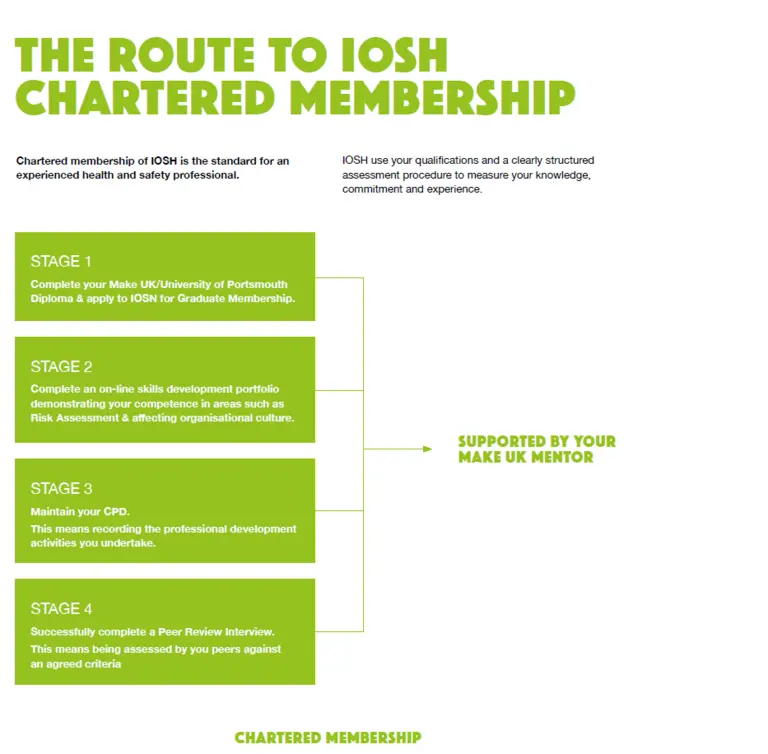31/01/2020
In 2018 I wrote a blog which explained why prospective employers shouldn’t look at qualifications when assessing a candidate’s suitability for a senior health & safety role. Rather, they should look at overall competency as required by health & safety law.
The point of that blog was to explain that, although it doesn’t sound like it, this method is actually easier as the work is already done for us by our professional body, the Institute of Occupational Safety & Health (IOSH).
So, I thought, it’s only fair to do the same for those on the other side of the equation, the health & safety professional.
Let’s start with the different IOSH membership grades & what is required to attain each level. Not all levels are covered, I’ve started with Technical Membership. Also, there are other routes you can take like the NVQ route, but the below seems to be the most popular:
| IOSH Membership Level | Requirements | Annual-Fee |
|---|---|---|
| Technical Member (TechIOSH) | A QCF Level 3 Certificate such as the University of Portsmouth Certificate in Health & Safety Management or the NEBOSH Certificate & 2 year's vocational experience in a health & safety role. | £130 |
| Graduate Member (GradIOSH) | A QCF Level 10 Diploma such as the University of Portsmouth Diploma in Health, Safety & Risk Management or the NEBOSH Diploma. | £145* |
| Chartered Member (CMIOSH) | At least 2 years at Graduate level, a detailed record of initial professional development covering 5 specific elements & successful completion of a Peer Review Interview. | £165 |
| Chartered Fellow (CFIOSH) | At least 5 years at Chartered level, a portfolio detailed your involvement outside of your employed work, e.g. voluntary work or significant contributions to the health & safety field. | £180 |
*Graduate Members pay a one-off charge of £160 when they register to start initial professional development (IPD)
These membership levels really mean something to both peers & organisations that know what they’re talking about. They demonstrate the three elements that truly make up competency & ensure they are dealing with someone who knows what they’re talking about.
- Qualification – To be a graduate member you have to have attained a Level 10 qualification endorsed by IOSH, like the Portsmouth or NEBOSH Diplomas.
- Experience – To become chartered, you have to not only show that you have the qualification, but, you also that you have done something with it over a 2 year period.
- Continued Development – At any of the 4 levels explained here, you have to demonstrate that you are continually developing your skills. This is done through an online portal that is very closely monitored by IOSH.
This, in a nutshell is why organisations should look at IOSH membership levels rather than qualifications that may just prove you’re good at exams. In my experience, most “in the know” organisations are looking for a chartered health & safety practitioner for their senior health & safety roles. So let’s look at that journey in more detail.

Stage 1
The most common route starts with Graduate Membership, so first you need a Diploma or similar.
There are many different choices here, but they broadly fit into 2 categories:
a) Coursework-based qualifications like the University of Portsmouth Diploma which is delivered via a blended model using a mix of face to face modules delivered by industry experts & powerful on-line content, or the NCRQ Diploma with is delivered via distance learning.
b) Exam-based qualifications like the NEBOSH Diploma.
The question here is, what suits you & your learning style best? If you thrive in the exam environment, option a) is for you. If you would rather “learn by doing” via case studies based in your own workplace, we’d recommend the University of Portsmouth Diploma.
Stages 2 & 3
Once you have your Diploma, you can join IOSH as a Graduate member without further ado. The next step to Chartered Membership is to build your IPD Portfolio. You must have a minimum of 2 years’ experience at Graduate level to do this. Your portfolio must show validated evidence of your work in the following areas:
i) Developing a positive safety culture
ii) Developing positive health & safety policies
iii) Developing effective communications systems
iv) Assessing risk
v) Managing risk
This evidence is very carefully examined, validated & signed-off by IOSH
Stage 4
The Interview. This is often the part of the process which most candidates dread, but there is really no need. I have chaired & sat on many interview panels & we do everything we can to ensure that the candidates are comfortable & understand exactly what the interview is about. We are seeking to check that you did what you say you did in your portfolio by asking pre-determined question sets. No one will be asking you to explain the three actions levels in the Noise at Work Regulations, 2005!
The Interview consists of a presentation taking no more than 15 minutes & the interview which lasts no more than 45 minutes.
After successful completion of this stage, you get your Chartered Membership.
IOSH have even filmed this mock interview to allay any remaining fears
Note: The candidate in the film went through the NVQ5 route which requires an additional examination before a panel can be held.
And of course, don’t forget that Make UK are here to help mentor you every step of the way & are as committed as you are to elevating yourself along the path to professional recognition.
